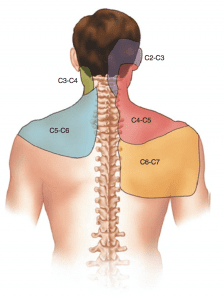What’s Facet Mediated Pain? Here’s how it’s relieved and managed with chiropractic care
Do you feel a sharp pain that’s aggravated by simple everyday movements, like leaning back, twisting or turning? This discomfort – commonly referred to as facet syndrome – can affect the joints in the back and impact the enjoyment of your day to day life.In this blog, Dr. David Russo, Chiropractor (BChiroSci, MChiro) gives us a comprehensive overview of Facet Mediated Pain and how chiropractic care can help you find relief.
What is a facet joint?
Facet joints are the joints that connect all the vertebrae in your back. There are 2 on each side, behind the disc, and they are surrounded by a fibrous capsule. They contain cartilage (which act as shock absorbers), similar to the knee joint, and synovial fluid to lubricate the structures inside, assisting with joint movement. Facet joints provide stability and mobility for the spine, with each spinal level working in congruence with the joints above and below. The shape and directions of our facet joints differ as you go down the spine, allowing for different ranges of movement. Our facet joints have thousands of nerve endings, which provide sensory information to our brains and nervous system. They play an important role in allowing our joints to know where they are in space, and to coordinate joints efficiently and with stability. Injured or inflamed facet joints can mimic other injuries (such as a disc injury or sciatica) and can refer pain to different areas of the body.
What is facet mediated pain?
It is commonly referred to as a facet syndrome, capsulitis or synovitis. Chiropractors often use the term “Facet joint dysfunction”. It can affect the joints of the low back, neck or middle back.This condition is characterised by a sharp pain that is aggravated by movements such as leaning backwards, twisting or turning. Many painful back or neck conditions (like whiplash or wry neck) have some type of facet joint injury or inflammation.
What causes facet mediated pain?
There are many causes of facet joint pain. Here are a few examples:
Sustained poor posture
Whiplash or trauma
Weak stabilisers (such as the core and the neck flexors)
Overuse/overstretching the capsule
Faulty biomechanics
Any number of the structures mentioned above could be the cause of the pain. Because of the small size and close proximity of all the structures in the joint, it can be difficult to determine what specific structure is compromised in the joint.
How can Chiropractic help?
At the Sydney Spine and Sports Clinic, our experienced and highly qualified chiropractors offer evidence based and hands on techniques such as manipulation/mobilisation, rehab, and soft tissue release that can used to treat facet mediated pain.Chiropractic care can help to:
• Reduce pain
• Increase joint movement
• Help surrounding joints to function normally
As a result of the facet joint being injured, the surrounding muscles tend to tense up and shorten to protect the joint from further injury. Methods such as soft tissue release, dry needling and muscle stretching can be used together with specific manual therapy techniques to promote the healing process and desensitise your pain.Preventive techniques can be employed to decrease the likelihood of any further flare ups. Rehabilitative exercises are given for you to perform at home to ensure the surrounding areas get strengthened, which assists in unloading the joint in the future. This will also assist in the joint being able to bear greater loads in the future as well.Our team at the Sydney Spine and Sports clinic offers a safe, non-invasive, and most importantly a long-lasting form of spine pain relief that benefits all members of the family.For more information or to book an appointment, contact us here.By Dr David Russo, Chiropractor (BChiroSci, MChiro)
--------------------
References:
Little JS, Ianuzzi A, Chiu JB, Baitner A, Khalsa PS. Human lumbar facet joint capsule strains: II. Alteration of strains subsequent to anterior interbody fixation. The spine journal : official journal of the North American Spine Society. 2004;4(2):153-62.
Nance PW, Adcock EM. Facet Mediated Pain [document on the Internet]. PM&R Knowledge NOW; 2011 [cited 2018 May 4]. Available from: https://now.aapmr.org/facet-mediated-pain/
Ramsook RR, Bryce TN. Facet-Mediated Pain. 2017:341-3.
Image reference:
Ramsook RR, Bryce TN. Facet-Mediated Pain. 2017:Fig 77.1.



